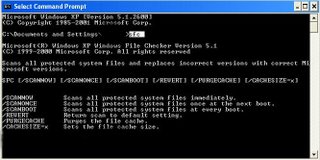How To System File Checker
Description:
The System File Checker tool gives you the ability to scan all of the protected files to verify their versions. The System File Checker tool also checks and repopulates the %SystemRoot%\System32\Dllcache folder. If the Dllcache folder becomes damaged or unusable, you can use either the sfc /scanonce or sfc /scanboot command to repair the contents of the folder. You must be logged on as administrator or as a member of the Administrators group to run System File Checker. The average user will only be concerned with first two switches.
How to open SFC Syntax:
Goto Start > All Programs > Accessories > Command prompt and type SFC followed by one or more of the following switches:

The System File Checker tool gives you the ability to scan all of the protected files to verify their versions. The System File Checker tool also checks and repopulates the %SystemRoot%\System32\Dllcache folder. If the Dllcache folder becomes damaged or unusable, you can use either the sfc /scanonce or sfc /scanboot command to repair the contents of the folder. You must be logged on as administrator or as a member of the Administrators group to run System File Checker. The average user will only be concerned with first two switches.
How to open SFC Syntax:
Goto Start > All Programs > Accessories > Command prompt and type SFC followed by one or more of the following switches:

- The /scannow command scans all protected system files and replaces incorrect versions with correct Microsoft versions. This command also repopulates the DLLCache folder with the most recent versions of protected files. This requires access to the Windows installation source files and also the installed Service Pack files. You are usually prompted for the location of these files during the scan operation.
- The /scanonce command scans all protected system files once. This command requires access to the Windows installation source files.
- The /scanboot command scans all protected system files every time that you start your computer. This command requires access to the Windows installation source files.
- The /cancel command cancels all pending scans of protected system files.
- The /enable command enables WFP for normal operation.
- The /purgecache command purges the file cache and scans all of the protected system files immediately. This command requires access to the Windows installation source files. This command is required after you run the /cachesize=x command.
- The /cachesize=x command sets the file cache size in megabytes (MB). This command will require a reboot followed by a /purgecache command to adjust the size of the on-disk cache.
- The /quiet command replaces all incorrect file versions without prompting the user.
- For XP and Windows 2003 systems only:The /revert command returns scan to the default setting (Note: do not scan protected files when you start the computer). The default cache size is not reset when you run this command. This command would be equivalent to the /Enable switch in Windows 2K.
|


<< Home